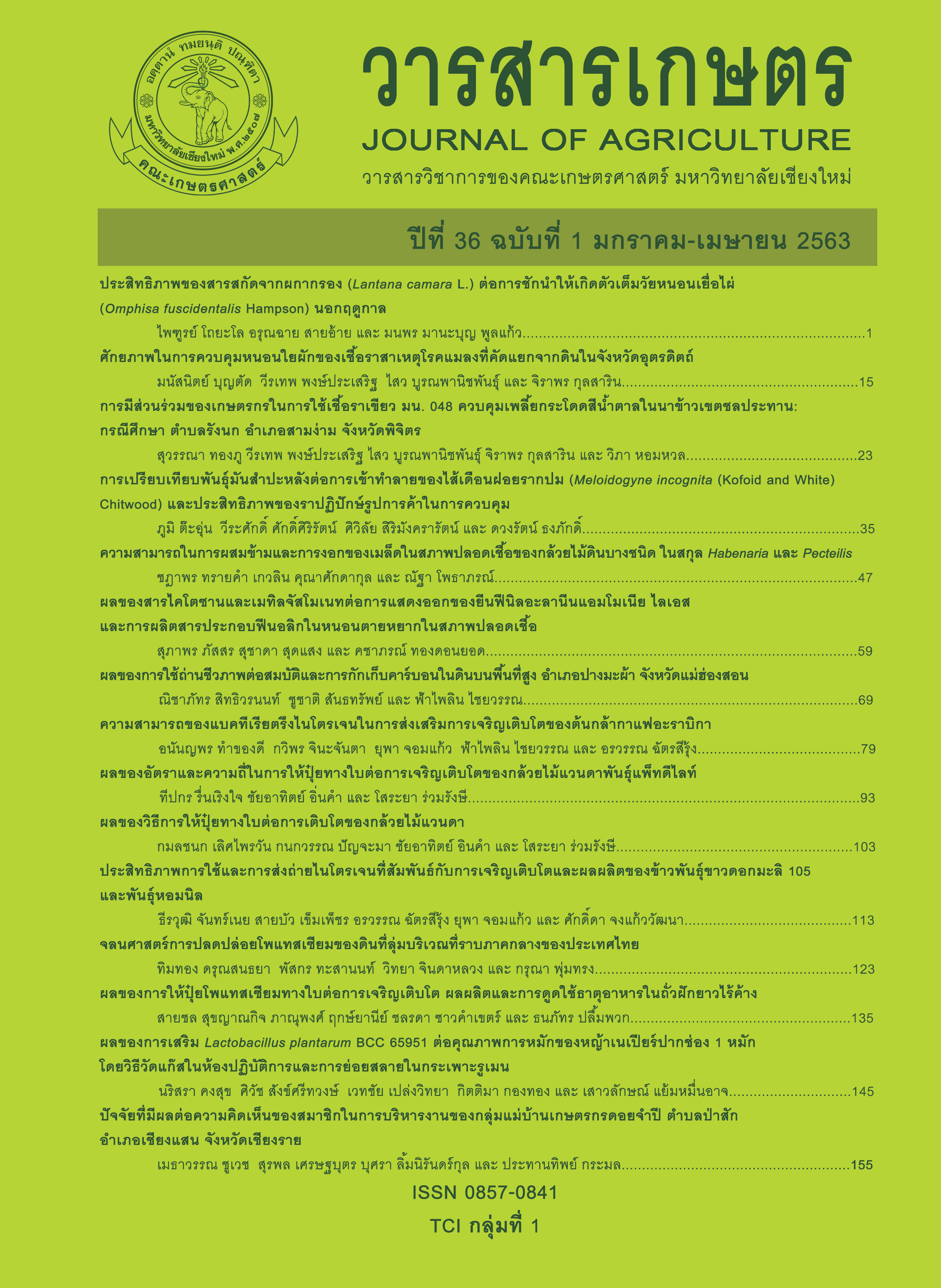Effects of Chitosan and Methyl Jasmonate on Phenylalanine Ammonia Lyase (<I>PAL</I>) Gene Expression and Phenolic Compound Production in <I>In Vitro</I> Plantlets of <I>Stemona collinsae</I> Craib.
Main Article Content
Abstract
The effect of chitosan and methyl jasmonate on the induction of phenylalanine ammonia lyase (PAL) and phenolic compound content in Stemona collinsae Craib. was conducted in this study. In vitro S. collinsae plantlets were stimulated for one and two weeks with various concentrations of elicitors. The observation found that PAL gene expression in root and shoot part of S. collinsae plantlets responded to elicitors depending on the concentration of stimulants, stimulation period and stage of plant growth. The shoot part of the 12 month-old S. collinsae plantlets stimulated with 100 mg/l chitosan showed the highest expression of PAL which was 3.93 fold higher than those determined in control and root part of stimulated plant. In addition, amount of total phenolic compound was 73.01 mg GAE/100g fresh weight which was 1.2 fold compared with the control. The 0.3 µM methyl jasmonate stimulation for one week increased the PAL gene expression at the highest level in the root part by 8.66 times, resulting an increase of the total phenolic content at 88.37 mg gallic acid per 100 g fresh weight which was 1.2 times higher than control. Comparing the effect of stimulation on stage of growth between 6 month-old and 12 month-old S. collinsae plantlets by adding 100 mg/l chitosan and 0.3 µM methyl jasmonate for one week, it was found that the amount of phenolic compounds obtained from all conditions were not significant different (P> 0.05) when compared to control.
Article Details
References
Adams, M., T. Pacher, H. Greger and R. Bauer. 2005. Inhibition of leukotriene biosynthesis by stilbenoids from Stemona species. Journal of Natural Products 68(1): 83-85.
Akanitapichat, P., P. Tongngok, A. Wangmaneerat and B. Sripanidkulchai. 2005. Anitiviral and anticancer activities of Stemona collinsae. Thai Journal of Pharmaceutical Sciences 29(3-4): 125-136. (in Thai)
Chang, J., J. Luo and G. He. 2009. Regulation of polyphenols accumulation by combined overexpression/silencing key enzymes of phyenylpropanoid pathway. Acta Biochimica et Biophysica Sinica 41(2): 123-130.
Iriti, M and F. Faoro. 2009. Chitosan as a MAMP, searching for PRR. Plant Signaling and Behavior 4(1): 66-68.
Jirapongpattana, R., Y. Jirakiattikul and P. Rithichai. 2017. Effects of jasmonic acid and yeast extract on secondary metabolite contents in shoot culture of Dioscorea birmanica Prain & Burkill. Thai Journal of Science and Technology 25(3): 485-496. (in Thai)
Kamalipourazad, M., M. Sharifi, H.Z. Maivan, M. Behmanesh and N.A. Chashmi. 2016. Induction of aromatic amino acids and phenylpropanoid compounds in Scrophularia striata Boiss. cell culture in response to chitosan-induced oxidative stress. Plant Physiology and Biochemistry 107: 374-384.
Khitka, B. 2014. Influence of methyl jasmonate on antioxidant activity and nutritional value of Red oak lettuce in hydroponics farming system. Khon Kaen Agricultural Journal 42(Supplement 1): 652-657. (in Thai)
Kim, D.O., S.W. Jeong and C.Y. Lee. 2003. Antioxidant capacity of phenolic phytochemicals from various cultivars of plums. Food Chemistry 81(3): 321-326.
Livak, K.J. and T.D. Schmittgen. 2001. Analysis of relative gene expression data using real-time qualitative PCR and the 2−ΔΔCT method. Methods 25(4): 402-408.
Lopez-Moya, F., M. Suarez-Fernandez and L.V. Lopez-Llorca. 2019. Molecular mechanisms of chitosan interactions with fungi and plants. International Journal of Molecular Sciences 20(2): 332, doi: 10.3390/ ijms20020332.
Montri, N. and S. Saenphakdi. 2014. Effect of paclobutrazol on growth and development and total stemona alkaloids accumulation in root of Stemona curtisii Hook. F. in vitro. Khon Kaen Agricultural Journal. 42(Supplement 1): 602-608. (in Thai)
Palee, J., S. Dheeranupattana, S. Wangkarn, S.G. Pyne and A.T. Ung. 2016. Effects of chitosan and salicylic acid on Stemona alkaloid production in hydroponic culture of Stemona curtisii Hook. f. Chiang Mai Journal of Science 43(5): 1070-1076.
Roupe, K.A., C.M. Remsberg, J.A. Yanez and N.M. Davies. 2006. Pharmacometrics of stilbenes: seguing towards the clinic. Current Clinical Pharmacology 1(1): 81-101.
Raskin, I., D.M. Ribnicky, S. Komarnytsky, N. llic, A. Poulev, N. Borisjuk, A. Brinker, D.A. Moreno, C. Ripoll, N. Yakoby, J.M. O’Neal, T. Cornwell, I. Pastor and B. Fridlender. 2002. Plants and human health in the twenty-first century. Trends in Biotechnology 20(12): 522-531.
Shakya, A., G. Marslin, K. Siram, L. Beerhues and G. Franklin. 2017. Elicitation as a tool to improve the profiles of high-value secondary metabolites and pharmacological properties of Hypericum perforatum. Journal of Pharmacy and Pharmacology 71: 70-82.
Singh, A. and P. Dwivedi. 2018. Methyl-jasmonate and salicylic acid as potent elicitors for secondary metabolite production in medicinal plants: A review. Journal of Pharmacognosy and Phytochemistry 7(1): 750-757.
Thakur, M., S. Bhattachary, P.K. Khosla and S. Puri. 2019. Improving production of plant secondary metabolites through biotic and abiotic elicitation. Journal of Applied Research on Medicinal and Aromatic Plants 12: 1-12.
Wasternack, C. and M. Strnad. 2019. Jasmonates are signals in the biosynthesis of secondary metabolites - pathway, transcription factors and applied aspects - A brief review. New Biotechnology 48: 1-11.
Xing, K., X. Zhu, X. Peng and S. Qin. 2015. Chitosan antimicrobial and eliciting properties for pest control in agriculture: a review. Agronomy for Sustainable Development 35: 569-589.
Zhang, X. and C.J. Liu. 2015. Multifaceted regulations of gateway enzyme phenylalanine ammonia-lyase in the biosynthesis of phenylpropanoids. Molecular Plant 8(1): 17-27.


